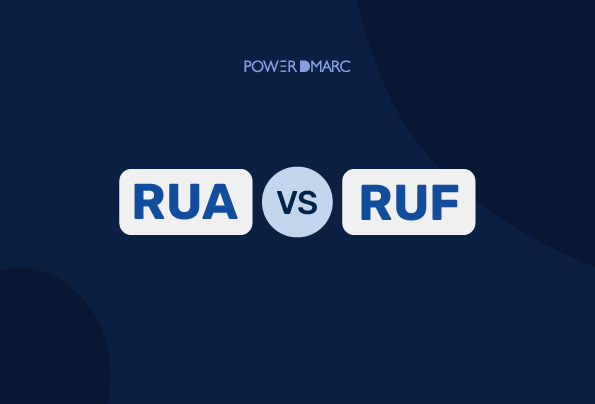DMARC protocol offers wide-angle visibility into your email-sending domain’s activity to help you track its nefarious and illegitimate use. This boosts email security and ensures a good delivery rate while keeping phishers and spammers at bay.
There are two types of reports that are sent to give you an overview: DMARC RUA vs. RUF. The RUA and RUF reports are alternatively called aggregate and forensic reports, respectively. This guide discusses the major differences between them and how they work.
However, please note that in order to understand RUA vs. RUF reports and start receiving them, you first need to create a DMARC record and publish it on your domain’s DNS.
Key Takeaways
- DMARC provides visibility into email activity, helping to secure domains against spoofing and phishing.
- RUA reports document aggregate data on email authentication failures, aiding in the identification of fraudulent activity.
- RUF reports offer forensic-level details that help uncover vulnerabilities in the email system.
- Implementing DMARC is essential for instructing recipient servers on handling emails that fail authentication checks.
- Refining email authentication policies based on RUA and RUF reports improves overall email security over time.
What is a DMARC RUA Report?
DMARC RUA report includes information about your domain’s email traffic. When you create a DMARC report, you set one of the DMARC policies (none, quarantine, or reject) to instruct recipients’ servers on how to treat illegitimate emails coming from your domain. So, when an email dispatched from your domain fails SPF and/or DKIM authentication checks, the receiving server produces a DMARC RUA report notifying you of this failure. The report is sent to a pre-specified RUA URI.
Simplify RUA vs RUF with PowerDMARC!
What Does a DMARC RUA Report Contain?
Here’s what a RUA report has-
-
Failed Authentication Details
This part includes information such as the sending server’s IP address, the authenticated domain, and specific authentication mechanisms that failed (SPF and/or DKIM).
-
Message Headers
This helps you trace the culprit and identify any potential issues with your email infrastructure.
-
Authentication-Results
Details about the results of SPF and DKIM checks, including whether they passed or failed and any relevant error messages.
-
Message Count
The total number of emails that failed authentication checks and are treated as per the DMARC policy set in the record.
-
Policy Evaluation
This section specifies what actions were taken against emails that came from unauthentic senders.
How Does DMARC RUA Report Work?
A standard DMARC RUA report process works as follows-
1. DMARC Implementation
The foremost step is to deploy the DMARC protocol and specify a policy instructing how receiving mail servers should treat emails failing authentication checks.
2. Email Authentication
Once an email is dispatched, the recipient’s server evaluates if the sender is authorized to send emails on behalf of the domain. This is checked by comparing the list of senders mentioned in the SPF record and the DKIM digital signature.
3. DMARC Check
The receiving server takes action against illegitimate messages as per the policy set in your domain’s DMARC record.
4. RUA Report Generation
If your DMARC report includes a reporting mechanism, the recipient’s server will produce an RUA report for all the emails dispatched from your domain but failed SPF and/or DKIM authentication checks.
The RUA report generated contains detailed information about the failed authentication, including the sender’s IP address, the authentication methods used, and the reason for the failure.
5. RUA Report Dispatch
The produced RUA report is sent to the designated RUA URI, which is typically an email address controlled by the domain owner, domain administrator, or a third-party service provider like PowerDMARC.
6. Aggregation and Analysis
The report is studied properly to identify and take action against malicious senders or to rectify existing issues.
7. Policy Refinement
Domain owners can use the information from RUA reports to refine their email authentication policies, allowing legitimate email sources while blocking unauthorized senders more effectively. This iterative process improves email security over time.
What is the DMARC RUF Report?
A DMARC RUF report is a comprehensive dossier including forensic-level details about emails that fail authentication checks. This lets domain owners or administrators know about potential vulnerabilities and unauthorized email attempts. In addition to it, you can understand if and why there are any occurrences of false positives.
What Does a DMARC RUF Report Contain?
On receiving a DMARC RUF report, you’ll come across the following piece of crucial information-
Authentication-Results
It elucidates if SPF and DKIM checks were successful, which navigates domain owners through their domain’s email utility patterns.
Message Headers
This section furnishes information like- email sender, recipient, subject line, and timestamps, which helps comprehend the context of the failed emails. You also get an overview of why some of your genuine emails aren’t passing the authentication filters.
Message Content
The content of suspicious messages is displayed for domain owners to scrutinize it to track down the culprits, if possible. Tracing links and attachments helps connect the dots.
Encryption Details
RUF reports can be encrypted to ensure data privacy and security, safeguarding the sensitive information contained within them during transmission and storage.
How Does DMARC RUF Report Work?
The overall process of generating and sending DMARC RUF reports is almost similar to the RUA report. You need to include a reporting mechanism in your DMARC record and publish it to DNS.
The receiving server produces an RUF report for every email that’s unsuccessful in passing authentication filters, detailing the failure and its specifics.
Finally, the generated RUF report is emailed to the specific RUF URI, which is followed by a detailed analysis.
Conclusion
RUA and RUF reports offer organizations the power to dissect authentication processes, secure email domains, and effectively thwart malicious activities. By harnessing these reports’ insights, organizations remain at the forefront of email security, safeguarding their reputation and stakeholders’ trust.
We at PowerDMARC uncomplicate these reports by automatically translating them into an easy-to-read format that can be comprehended by anyone- you don’t have to be a tech ninja!
Moreover, if the security of sensitive information in your emails is a priority for you, we provide options for encrypting forensic reports, both automatically and when requested.

- Best Domain Security Management Solutions to Protect Your Digital Identity - August 29, 2025
- Microsoft Limits Onmicrosoft Domain Usage for Email Sending - August 25, 2025
- Zero Day Vulnerability: Examples, Detection, and Prevention - August 25, 2025



